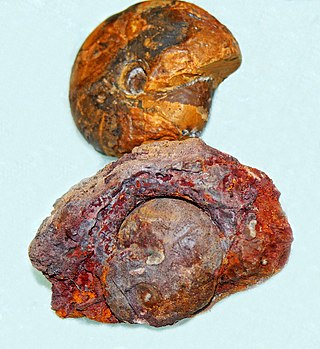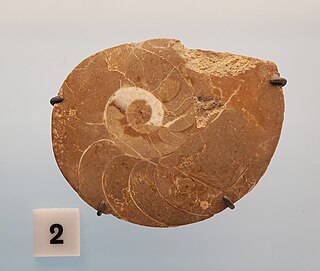
Goniatites is a genus of extinct cephalopods belonging to the family Goniatitidae, included in the superfamily Goniatitaceae. Hibernicoceras and Hypergoniatites are among related genera.

Ammonitida or "True ammonites" are an order of ammonoid cephalopods that lived from the Jurassic through Paleocene time periods, commonly with intricate ammonitic sutures.

Xenodiscus is an extinct genus of ammonoid cephalopod and one of the earliest known ceratites, found in the Upper Permian of northern India and Timor. Xenodiscus is included in the family Xenodiscidae which is part of the ceratite superfamily Xenodiscaceae.
Xenoceltites is an extinct genus of ceratite ammonoid found worldwide in the Lower Triassic.
Aristoceras is a Late Paleozoic goniatitid genus included in the Goniatitina suborder in which the lobes of the external suture are irregularly serrate.

Beyrichoceras is a genus belonging to the goniatitid family Maxigoniatitidae that lived during the Mississippian Period
Dimeroceratidae is one of three families in the Dimeroceratoidea, a goniatid superfamily included in the Ammonoidea; extinct shelled cephalopods with adorally convex septa and usually narrow ventro-marginal siphuncles.
Tornoceratoidea, also known as Tornocerataceae, is a superfamily of goniatitid ammonoids included in the suborder Tornoceratina. Tornoceratoidea, or Tornocerataceae, is essentially the Cheilocerataceae of Miller, Furnish, and Schindewolf (1957) in the Treatise Part L, revised to accommodate new taxa and new perspectives on the phylogeny.
Tornoceratidae is a family of goniatitid ammonoids from the middle and upper Devonian. The family is included in the suborder Tornoceratina and the superfamily Tornoceratoidea.
Texoceras is an extinct ammonoid genus in the monotypic goniatitid subfamily Texoceratinae, included in the family Adrianitidae. These were shelled cephalopods more closely related to squids, belemnites, octopuses, and cuttlefish than to nautiloids from which they are derived.

Medlicottiidae is a family of ammonoid cephalopods belonging to the Prolecanitida, known from the Upper Carboniferous (Pennsylvanian) to the Early Triassic.

Mimagoniatites is a genus of ammonoid cephalopod which lived during the early Devonian, regarded as belonging to the Agoniatitdae as a member of the subfamily Mimagoniatitinae.

Clymeniida is an order of ammonoid cephalopods from the Upper Devonian characterized by having an unusual dorsal siphuncle. They measured about 4 cm (1.6 in) in diameter and are most common in Europe, North Africa, and South China but are known from North America and Australia as well.
Sosioceras is an Upper Permian shouchangoceratin pseudohaloritid characterized by a subdiscoidal shell, about 2 cm in diameter, marked by growth lines, as with Neoaganides, and having a mature peristome with a double constriction near the periphery. The suture also closely resembles that of Neoaganides.
Cravevoceras is an Upper Paleozoic ammonite in the goniatite family Cravenoceratidae, probably derived from Pachylyroceras and contemporary with other cravenoceratid genera like Caenolyroceras, Tympanoceras and later Alaoceras and Lyrogoniatites. It is also a member of the Neoglyphioceratoidea.
The Uddenitinae a subfamily of the Medlicottiidae, a family of ammonoid cephalopods included in the Prolecanitida. The Uddenitinae, proposed by Miller and Furnish, and known from the Pennsylvanian and Lower Permian, are transitional between the ancestral Pronoritidae and the more traditional medlicottiids.

The Medlicottiinae is a subfamily of the Medlicottiidae, a family of ammonoid cephalopods included in the Prolecanitida, characterized by having discoidal to thinly lenticular shells with a retuse (grooved) venter and sutures with bifid auxiliary lobes.
Acanthoclymeniidae is a family of early, primitive, clymeniid ammonoid cephalopods that lived during the Late Devonian. At one time this family was known to contain a single genus, Acanthoclymenia, named by Hyatt in 1900, which is its type.

Ophiceras is an extinct genus of smooth, evolute ceratitid ammonites from the Griesbachian, with a rounded venter. Fossils of the genus have been found in Armenia, Azerbaijan, China, Greenland, and India.

Meekoceras is an extinct genus of ceratitid ammonites with a discoidal shell that lived during the Early Triassic Epoch.








